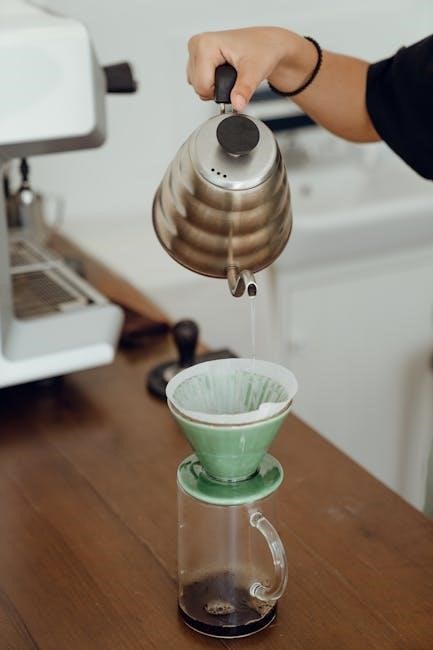
truma hot water system manual
Truma Hot Water System Manual: A Comprehensive Guide
Welcome to your comprehensive guide designed to help you get the most out of your Truma hot water system. This manual provides essential information, operating instructions, and troubleshooting tips. Follow the provided guidelines for safe and efficient operation. Always prioritize your safety by following these instructions!
Understanding Truma Hot Water Systems
Truma hot water systems are designed to provide a residential-like hot water experience in recreational vehicles. These systems offer instant and consistent hot water, enhancing comfort during travel and camping. Unlike traditional RV water heaters, Truma systems often utilize on-demand technology, eliminating the need to wait for a tank to heat up, saving time and energy. These systems are compact and lightweight, making them suitable for installation in tight spaces.
Understanding the core principles of how Truma systems function is crucial for proper operation and maintenance. Features like high-efficiency heat exchangers ensure ample hot water for various needs. Some models, such as the AquaGo, include advanced features like automatic decalcification programs to extend the system’s lifespan. It is important to note that specific models have unique characteristics, so consulting the appropriate manual is always recommended.
These systems are engineered for safety and convenience, offering features like consistent temperature output to prevent scalding. Familiarizing yourself with these systems will help you address common issues. Remember that Truma offers resources, including manuals and customer support, for assistance.
Available Truma Hot Water System Models
Truma offers a range of hot water systems designed to meet diverse needs in recreational vehicles; Among the popular models, the Truma AquaGo stands out for its on-demand, continuous hot water delivery. The AquaGo Comfort and Comfort Plus models provide advanced features, such as enhanced temperature stability and user-friendly controls. These models offer a residential-like experience in your RV.

The Truma AquaGo basic is a more streamlined option. It provides essential on-demand hot water capabilities in a compact and lightweight package. It is ideal for installations where space is limited. The Truma Therme is another system, typically used where smaller hot water volumes are needed. It is known for its quick heating capabilities.
Each Truma model has unique specifications. Before choosing a system, consider your RV’s water usage and available space. Consulting the product manuals for each model will help you understand their specific features, installation requirements, and operating instructions. This will also ensure you select the best hot water solution for your needs. Remember to always refer to the official Truma documentation for the most accurate and up-to-date information.
Operating Instructions for Truma AquaGo
To properly operate your Truma AquaGo, start by ensuring the system is correctly installed according to the installation manual. Before first use, flush the system thoroughly with approximately 8 gallons of water to remove any manufacturing residue. Locate the toggle switch on the exterior of the AquaGo unit and turn it on.
When connected to a water source, the AquaGo will automatically heat water as needed, providing near-instant hot water at your taps. A blinking red LED light below the toggle switch may indicate specific system statuses; refer to the manual for light code interpretations. The AquaGo Comfort and Comfort Plus models may feature a control panel inside the RV, allowing temperature adjustments.
Always read the complete operating instructions in your Truma AquaGo manual. This ensures safe and efficient use of the system. It is important to understand the appliance is only for heating tap water in recreational vehicles. If you encounter any issues, consult the troubleshooting section. Never attempt repairs beyond those described in the manual. For complex issues, contact a certified technician for assistance.
AquaGo Basic Features and Usage
The Truma AquaGo basic is designed as a compact and lightweight instant water heater specifically for recreational vehicles, offering a convenient hot water solution in confined spaces. A key feature is its high-efficiency heat exchanger, ensuring a consistent supply of hot water for showers, sinks, and other on-demand needs. Unlike some models, the AquaGo basic lacks frost protection, emphasizing the importance of proper winterization to prevent damage in freezing conditions.
To use the AquaGo basic, ensure it’s correctly connected to both water and power sources. Once activated, it heats water almost instantaneously, eliminating long wait times. The system is designed for ease of use, providing hot water when and where you need it during your travels. Remember to always consult the user manual for specific operating instructions and safety guidelines.

The absence of frost protection in the basic model necessitates careful attention to winterizing procedures. This includes completely draining the system when temperatures drop below freezing. Avoiding the use of antifreeze unless a bypass kit is installed, as per the manufacturer’s instructions, is also essential for maintaining the system’s integrity; Following these precautions helps prolong the life of your AquaGo basic and ensures reliable performance.
Decalcification Procedures for Truma Systems
Regular decalcification is essential for maintaining the optimal performance and extending the lifespan of your Truma hot water system. Over time, mineral deposits, particularly calcium, can accumulate within the system, reducing its efficiency and potentially causing damage. Decalcifying helps to remove these deposits, ensuring the system continues to operate at its peak performance.
The decalcification process typically involves using a specialized decalcification solution designed for Truma systems. Follow the instructions in your system’s manual for the correct procedure and recommended solution. Generally, this involves draining the system, filling it with the decalcifying solution, allowing it to circulate for a specified period, and then thoroughly rinsing the system with fresh water;
For AquaGo models, Truma offers decalcification tablets that can be used to remove scale buildup. The manual provides step-by-step instructions on how to use these tablets, including the correct amount to use and the flushing procedure. Adhering to these instructions will ensure that the system is properly decalcified without causing damage. Furthermore, remember to consult your specific model’s manual for detailed instructions and safety precautions related to decalcification.
Winterizing Your Truma AquaGo
Proper winterization is crucial to prevent damage to your Truma AquaGo during freezing temperatures. Failure to winterize can result in cracked pipes, damaged components, and costly repairs. The AquaGo basic does not have frost protection and should not be used when there is a danger of freezing. Always consult your specific model’s manual for detailed instructions and safety precautions.
The winterization process typically involves draining all water from the system. Turn off the water supply and allow the system to cool off. Next, turn off the AquaGo at the toggle switch located on the outside of the unit. Open all faucets and drain plugs to allow water to escape. Some models may require the use of compressed air to thoroughly remove any remaining water from the lines.
Avoid using antifreeze solutions unless a bypass kit is installed; Refer to your manual for specific instructions on using antifreeze. Remember, proper winterization is essential to protect your Truma AquaGo from freezing damage and ensure its reliable performance for years to come. Always follow the steps outlined in your owner’s manual to ensure your system is properly protected during the winter months. Contact a qualified technician if you’re unsure about any part of the winterization process.
Troubleshooting Common Issues
Experiencing issues with your Truma AquaGo? Let’s explore some common problems and their potential solutions. If your AquaGo isn’t working, start by checking the power supply and ensuring the unit is switched on. Examine all water lines to confirm they are properly connected and free from kinks or obstructions. A blinking red LED light below the toggle switch often indicates an error.
No hot water? Verify the gas supply is adequate and the burner is igniting. Insufficient water pressure can also hinder performance. Check the water inlet filter for debris and clean if necessary. If you hear unusual noises, such as banging or gurgling, it may indicate air in the system. Flush the system to remove any trapped air.
If the water is not hot enough, the temperature setting may be too low. Adjust the temperature control accordingly. If the issue persists, decalcification might be needed. Only carry out repairs yourself if the solution is described in the troubleshooting guide of this manual. For complex issues, consult a qualified technician. Remember to consult your Truma AquaGo manual for specific troubleshooting steps and safety information.
Safety Instructions and Precautions
Prioritizing safety is crucial when operating your Truma hot water system. Always read and adhere to the consumer safety instructions before using the appliance. Scalding injuries can occur from hot water, so exercise caution when adjusting water temperatures. Temperatures exceeding 52°C (125°F) can cause severe burns.
Never modify the Truma AquaGo instant water heater for a positive grounding battery system. Ensure proper ventilation around the unit to prevent carbon monoxide buildup. Do not shorten the power cable or tamper with electrical components. Installation and service should be performed by certified technicians or qualified service agencies.
If you smell gas, immediately turn off the gas supply and ventilate the area. Do not use open flames or electrical devices until the odor dissipates. Regularly inspect the system for leaks or damage. If you notice any issues, discontinue use and seek professional assistance. Ensure the appliance is used only for heating tap water in recreational vehicles intended for recreation, travel, or camping. Following these guidelines ensures safe and reliable operation of your Truma hot water system. Remember: safety first!

Finding Manuals and Support Resources
Accessing the right resources is essential for maintaining and troubleshooting your Truma hot water system. Begin by visiting the Truma website’s download center, where you can find operating instructions, technical documents, and other helpful information for your specific model. These manuals provide detailed guidance on installation, operation, and maintenance procedures.
For additional support, consult the FAQs section on the Truma website. This section addresses common questions and issues, offering quick solutions to frequently encountered problems. If you require more personalized assistance, contact Truma customer service directly. Their knowledgeable representatives can provide expert advice and guidance.
Consider joining online forums and communities dedicated to RV owners and Truma product users. These platforms offer valuable insights, tips, and troubleshooting advice from experienced individuals. You can also find local certified service technicians through Truma’s dealer locator. These technicians are trained to diagnose and repair Truma systems, ensuring professional and reliable service. Utilizing these resources will help you keep your Truma hot water system functioning optimally for years to come. Remember to always have your model number available when seeking support.

Installation Guide for Truma Hot Water Systems
Proper installation is crucial for the safe and efficient operation of your Truma hot water system. This guide provides general instructions, but always refer to the specific installation manual for your model. Before beginning, ensure you have all necessary tools and components. Installation and service must be performed by a certified service technician, service agency, or the gas supplier. Begin by carefully selecting a suitable location for the unit, ensuring adequate ventilation and accessibility for maintenance.
Follow the manufacturer’s instructions for connecting the water and gas lines. Ensure all connections are tight and leak-free. Verify the correct polarity when connecting the electrical components. If installing a Truma AquaGo, do not alter the unit for a positive grounding battery system. Consult the manual for specific wiring diagrams and grounding instructions. After completing the installation, test the system thoroughly to ensure it is functioning correctly.
Check for leaks, proper water temperature, and efficient heating. If you encounter any issues, consult the troubleshooting section of the manual or contact a qualified technician. Regular inspections and maintenance are essential for long-term reliability. Always adhere to safety precautions and local regulations during the installation process.